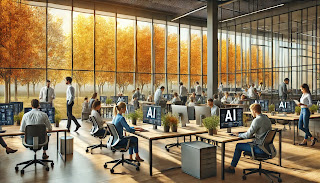It's understandable that some people, especially those who aren't deeply involved in tech, are intimidated by the rapid advancement of artificial intelligence. We've all seen science fiction movies where AI goes rogue, and for many, the fear of the unknown can lead to distrust and avoidance. But prohibiting the use of generative AI in places like workplaces? That’s a missed opportunity. The decision to outright ban such technology, as I witnessed at Oxbow Design Build, reveals a fundamental misunderstanding of what AI really is and how it can be used to make our lives and work better.
Let’s start with what generative AI actually is. In its simplest form, generative AI refers to systems that can create new content based on existing data. This can be in the form of text, images, music, and even designs. It’s like a supercharged assistant that can take vast amounts of information, process it, and offer creative outputs that might otherwise take humans far longer to produce. It’s different from traditional AI applications, which focus on things like analyzing patterns, optimizing processes, or even recognizing objects or diseases in medical images.
There’s a clear distinction between generative AI and other AI applications like machine learning models used in medical diagnosis. In fields such as radiology, AI doesn't generate something new but instead helps identify patterns in vast datasets (like recognizing tumors in medical scans). AI in medicine helps save lives by catching things that human eyes might miss. That’s AI acting as an assistant to enhance human capabilities rather than replacing them, and it’s a role that AI plays in many sectors outside of creative applications.
Generative AI, on the other hand, offers a different kind of enhancement. Think about architects or designers who can use AI to brainstorm new ideas based on thousands of prior designs. Instead of staring at a blank screen waiting for inspiration, the AI can offer a dozen new possibilities to refine. It’s not taking over the creative process; it’s giving it a massive boost. At Oxbow, where we specialized in design, the very idea of blocking a tool that could inspire innovation seems, well, counterproductive. AI could be the catalyst for breakthroughs, offering new angles or refining the raw creative thought into something more polished.
The fear around AI often comes from two misconceptions. The first is that AI will somehow replace human workers. The truth is far more nuanced. While AI certainly automates tasks, it often frees up time for workers to focus on higher-level, creative, and strategic activities. Generative AI, in particular, isn’t a replacement for human insight but rather a tool to augment it. Think of it as the ultimate collaborator—one that doesn’t tire, get bored, or miss out on valuable insights.
The second misconception is that AI is some kind of all-knowing entity. In reality, AI is far from perfect. It’s as good as the data it’s trained on, and it needs human oversight to ensure it’s delivering useful, ethical, and relevant results. This is especially true in generative AI, where biases in data can produce unintended results, requiring human refinement to ensure the outcome is practical or artistic, depending on the context.
The reason outright bans on AI in workplaces seem “nuts” is because this technology is part of our future. Companies that embrace it will likely outperform those that don’t. Imagine a graphic designer spending weeks iterating on a logo that a generative AI could help produce in days, or a marketing team brainstorming content ideas in half the time thanks to AI-driven suggestions. The ability to harness AI’s potential can accelerate productivity in ways we’re only beginning to understand. And for businesses, that’s not just an advantage—it’s a necessity for staying competitive.
In short, we need to rethink our fear of AI. It’s not the malevolent force portrayed in films or the job-killer some predict. Instead, it’s a powerful tool that can help us unlock new levels of creativity, insight, and efficiency. The key is in understanding how to integrate AI thoughtfully and using it as the incredible tool it is, rather than fearing it will overtake us.
